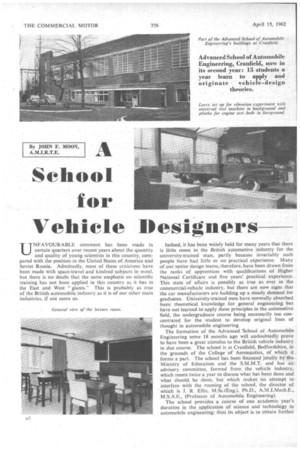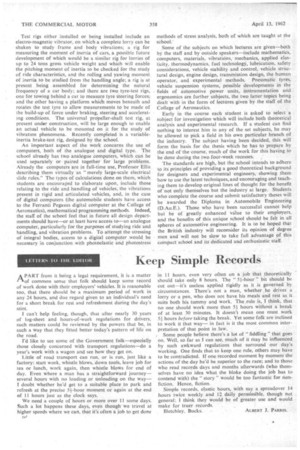Vehicle Designers
Page 52

Page 53

Page 54

If you've noticed an error in this article please click here to report it so we can fix it.
T JNFAVOURABLE comment has been made in certain quarters over recent years about the quantity and quality of young scientists in this country, compared with the position in the United States of America and Soviet Russia. Admittedly, most of these criticisms have been Made with space-travel and kindred subjects in mind, but there is no doubt that the same emphasis on scientific training has not, been applied in this country as it has in the East and West "giants." This is probably as true of the British automobile industry as it is of our other main industries, if not more so.
Indeed, it has been widely held for many years that there is little room in the British automotive industry for the university-trained man, partly because invariably such people have had little or no practical experience. Many of our senior design teams, therefore, have been drawn from the ranks of apprentices with qualifications of Higher National Certificate and five years' practical experience. This state of affairs is possibly as true as ever in the commercial-vehicle industry, but there are now signs that the car manufacturers are building up a steady demand for graduates. University-trained men have normally absorbed basic theoretical knowledge for general engineering but have not learned to apply these principles in the automotive field, the undergraduate course being necessarily too concentrated for the student to develop original lines of thought in automobile engineering.
The formation of the Advanced "School of Automobile Engineering some 18 months ago will undoubtedly prove to have been a great stimulus to the British vehicle industry in due course. The school is at Cranfield, Bedfordshire, in the grounds of the College of Aeronautics, of which it forms a part. The school has been financed jointly by the Ministry of Education and the S.M.M.T. and has an advisory committee,. formed from the vehicle industry, which meets twice a year to discuss what has been done and what should be done, but which makes no attempt to interfere with the running of the school, the director of which is T. R. Ellis, M.Sc.(Eng.), A.M.I.Mech.E., M.S.A.E., (Professor of Automobile Engineering).
The school provides a course of one academic year's duration in the application of science and technology to automobile engineering; thus its object is to obtain further
improvements in automobile design by imparting a souna knowledge of scientific and engineering theories. Each year's course consists of three 10-week terms and two four-week vacation periods, and before a student can complete the. course satisfactorily he has to produce a thesis combining both -theoretical and experimental work which, in addition, to showing sound theoretical and practical design knowledge, must also contribute something to the subject about which he is writing.
In addition to Professor•'Ellis there are two other lecturers, Mr. G. H. Tidbury, A.R.C.S., BSc., D.I.C., A.F,R.Ae.S. and Mr. D. Hodgetts, B.Sc.(Eng.), and in order that each student may receive the maximum amount of individual attention, each annual course is limited to .15 students. There are no age limits, although students are usually in their 20s, but rarely will a student be admitted to the school unless he has a degree in mechanical engineering or a Diploma in Technology.
All other things being equal, preference is normally given to students from S.M.TvI.T.-member companies, but students at last year's course came direct from university, from both vehicle and component manufacturers, and even, in one ease, from a large commercial-vehicle operating concern.
In the case of British students already working with manufacturers, their employers usually nominate them for entry to the school, in which case they are usually prepared to pay their salaries during their time at Cranfield and also the tuition and residential fees. The tuition charge for British students is £75, for Commonwealth students it is £250. and for foreign students the figure is £350. Accommodation for students is provided by the College of Aeronautics, this costing between £100 and £150 per annum.
British students resident in the United Kingdom who are accepted for entry are eligible, if not already supported by a sponsoring firm or institution, to make application for a grant from the College bursary fund or for a scholarship provided by Shell-Mex and Ltd.
Each course—and the second one is now in progress, the third being scheduled to start on October 8, 1962, finishing July 5, 1963—consists of lectures, laboratory demonstrations and individual research projects carried out under the supervision of a member of the staff. Laboratory equipment will eventually include test facilities for all types of engine (including gas turbines), vehicle structures, transmissions and propeller shafts, brakes, tyres, radiators and suspension dampers. When the facilities are complete there will be six engine test beds, the largest one being capable of absorbing 265 bhp. at 6,500 r.p.m. Already the school possesses one of the early Rootes two-stroke multi-fuel engines and this will be tested as soon as a suitable bed is completed. Also planned for the future is a single-cylinder engine with a quartz head to enable detailed studies to be made of combustion principles. Test rigs either installed or being installed include an electro-magnetic vibrator, on which a complete lorry can be shaken to study frame and body vibrations; a rig for measuring the moment of inertia of cars, a possible future development of which would be a similar rig for lorries of up to 24 tons gross vehicle weight and which will enable the pitching moment of inertia to be checked for the study of ride characteristics, and the rolling and yawing moment Of inertia to be studied from the handling angle; a rig is at present being assembled for determining the natural frequency of a car body; and there are two tyre-test rigs, one for towing behind a car to measure tyre steering forces; and the other having a platform whicih moves beneath and rotates the test tyre to allow measurements to be made of the build-up of force under braking, steering and accelerating conditions. The universal propeller-shaft test rig, at present under construction, will be large enough to enable an actual vehicle to be mounted on it for the study of vibration phenomena. Recently completed is a variableinertia brake-test rig, designed by the school.
An important aspect of the work concerns the use of computers, both of the analogue and digital type. The school already has two analogue computers, which can be used separately or paired together for large problems. Already the computers are in full-time use, Professor Ellis describing them virtually as "merely large-scale electrical slide rules." The types of calculations done on them, which students are encouraged to elaborate upon, include those relating to the ride and handling of vehicles, the vibrations present in rigid and articulated vehicles, and, in the case of digital computers (the automobile students have access to the Ferranti Pegasus digital computer at the College of Aeronautics), mathematical programming methods. Indeed, the staff of the school feel that in future all design departments should have—or at least have access to—an analogue computer, particularly for the purposes of studying ride and handling, and vibration problems. To attempt the stressing of integral bodies, access to a digital computer would be necessary in conjunction with photoelastic and photostress methods of stress analysis, both of which are taught at the school.
Some of the subjects on which lectures are given—both by the staff and by outside speakers—include mathematics, computers, materials, vibrations, mechanics, applied elasticity, thermodynamics, fuel technology, lubrication, safety considerations, vehicle stability and control, vehicle structural design, engine design, transmission design, the human operator, and experimental methods. Pneumatic tyres, vehicle suspension systems, possible developments in the fields of automotive power units, instrumentation and ergonomics are further subjects, the two latter topics being dealt with in the form of lectures given by the staff of the College of Aeronautics.
Early in the course each student is asked to select a subject for investigation which will include both theoretical analysis and experimental research. If a student can find nothing to interest him in any of the set subjects, he may be allowed to pick a field in his own particular branch of the industry. The subject having been decided, this will form the basis for the thesis which he has to prepare by the end of'the course, much of the work for this having to be done during the two four-week recesses.
The standards are high, but the school intends to adhere to its principles of providing a good theoretical background for designers and experimental engineers, showing them how to use the latest techniques, and 'encouraging and teaching them to develop original lines of thought for the benefit of not only themselves but the industry at large. Students who complete the course and submit satisfactory theses will be awarded the Diploma in Automobile Engineering (D.Au.E.). Those who have been successful cannot help but be of greatly enhanced vilue to their employers, and the benefits of this unique school should be felt in all spheres of automotive engineering. It is to be hoped that the British industry will reconsider its opinion of degree men and will not be slow to take full advantage of this compact school and its dedicated and enthusiastic staff.




















































































































